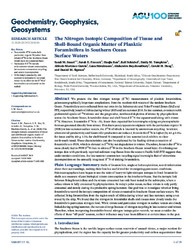The Nitrogen Isotopic Composition of Tissue and Shell-Bound Organic Matter of Planktic Foraminifera in Southern Ocean Surface Waters
Smart, Sandi M.
Fawcett, Sarah E.
Ren, Haojia
Tompkins, Emily M.
Stirnimann, Luca
Roychoudhury, Alakendra
Haug, Gerald H.
DOI: https://doi.org/10.1029/2019GC008440
Persistent URL: http://resolver.sub.uni-goettingen.de/purl?gldocs-11858/9415
Persistent URL: http://resolver.sub.uni-goettingen.de/purl?gldocs-11858/9415
Smart, Sandi M.; Fawcett, Sarah E.; Ren, Haojia; Schiebel, Ralf; Tompkins, Emily M.; Martínez-García, Alfredo; Stirnimann, Luca; Roychoudhury, Alakendra; Haug, Gerald H.; Sigman, Daniel M., 2020: The Nitrogen Isotopic Composition of Tissue and Shell-Bound Organic Matter of Planktic Foraminifera in Southern Ocean Surface Waters. In: Geochemistry, Geophysics, Geosystems, Band 21, 2, DOI: 10.1029/2019GC008440.
 |
Dokument öffnen: |
We present the first nitrogen isotope (δ15N) measurements of planktic foraminifera, paleoceanographically important zooplankton, from the nutrient-rich waters of the modern Southern Ocean. Foraminifera were collected from net tows in the Subantarctic and Polar Frontal Zones (SAZ and PFZ, respectively) south of Africa during winter 2015 and late summer 2016. In late summer, consistent with preferential uptake of 14N-nitrate and the progressive, northward depletion of nitrate by phytoplankton across the Southern Ocean, foraminifer tissue and shell-bound δ15N rise equatorward along with nitrate δ15N. However, foraminifer δ15N is ~3‰ lower than expected for heterotrophs relying on photosynthetic biomass generated directly from nitrate. This discrepancy appears to originate with the particulate organic N (PON) in late-summer surface waters, the δ15N of which is lowered by ammonium recycling. In winter, when overall productivity and foraminifer production are reduced, foraminifer δ15N is higher (by 4.6 ± 0.8‰ for tissue and by 4.0 ± 1.5‰ for shell-bound N compared to late summer) and exhibits no clear north-south trend. These characteristics can also be explained by the feeding-driven connection of foraminifera to PON, which is elevated in δ15N by net degradation in winter. Therefore, foraminifer δ15N is more closely tied to PON δ15N than to nitrate δ15N in the Southern Ocean mixed layer. Combining our isotope data with previously reported sediment trap fluxes from the western Pacific SAZ/PFZ suggests that, under modern conditions, the late-summer ammonium recycling signal outweighs that of wintertime decomposition on the annually integrated δ15N of sinking foraminifera.
Statistik:
ZugriffsstatistikSammlung:
This is an open access article under the terms of the Creative Commons Attribution License, which permits use, distribution and reproduction in any medium, provided the original work is properly cited.

